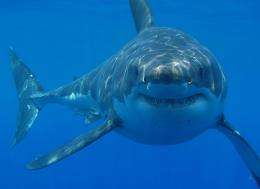Sharks can really sniff out their prey, and this is how they do it

It's no secret that sharks have a keen sense of smell and a remarkable ability to follow their noses through the ocean, right to their next meal. Now, researchers reporting online on June 10th in Current Biology have figured out how the sharks manage to keep themselves on course.
It turns out that sharks can detect small delays, no more than half a second long, in the time that odors reach one nostril versus the other, the researchers report. When the animals experience such a lag, they will turn toward whichever side picked up the scent first.
"The narrow sub-second time window in which this bilateral detection causes the turn response corresponds well with the swimming speed and odor patch dispersal physics of our shark species," known as Mustelus canis or the smooth dogfish, said Jayne Gardiner of the University of South Florida. All in all, it means that sharks pick up on a combination of directional cues, based on both odor and flow, to keep themselves oriented and ultimately find what they are looking for.
If a shark experiences no delay in scent detection or a delay that lasts too long—a full second or more—they are just as likely to make a left-hand turn as they are to make a right.
These results refute the popular notion that sharks and other animals follow scent trails based on differences in the concentration of odor molecules hitting one nostril versus the other. It seems that theory doesn't hold water when one considers the physics of the problem.
"There is a very pervasive idea that animals use concentration to orient to odors," Gardiner said. "Most creatures come equipped with two odor sensors—nostrils or antennae, for example—and it has long been believed that they compare the concentration at each sensor and then turn towards the side receiving the strongest signal. But when odors are dispersed by flowing air or water, this dispersal is incredibly chaotic."
Indeed, Gardiner explained, recent studies have shown that concentrations of scent molecules could easily mislead. Using dyes that light up under laser light, scientists found that there can be sudden peaks in the concentrations of molecules even at a distance from their source.
Gardiner's team suggests that the findings in the small shark species they studied may help to explain the evolution of the wide and flat heads that make hammerhead sharks so recognizable. One idea has held that the characteristic hammerhead may lend the animals a better sense of smell. But studies hadn't shown their noses to be all that remarkable, really. For instance, they don't respond to odors at concentrations lower than other sharks. The new findings suggest that the distance between their nostrils could be the key.
"If you consider an animal encountering an odor patch at a given angle, an animal with more widely spaced nostrils will have a greater time lag between the odor hitting the left and right nostrils than an animal with more closely spaced nostrils," Gardiner said. "Hammerheads may be able to orient to patches at a smaller angle of attack, potentially giving them better olfactory capabilities than pointy-nosed sharks." That's a theory that now deserves further testing.
In addition to giving insights into the evolution and behavior of sharks, the findings might also lead to underwater robots that are better equipped to find the source of chemical leaks, like the oil spill that is now plaguing the Gulf Coast, according to the researchers.
"This discovery can be applied to underwater steering algorithms," Gardiner said. "Previous robots were programmed to track odors by comparing odor concentrations, and they failed to function as well or as quickly as live animals. With this new steering algorithm, we may be able to improve the design of these odor-guided robots. With the oil spill in the Gulf of Mexico, the main oil slick is easily visible and the primary sources were easy to find, but there could be other, smaller sources of leaks that have yet to be discovered. An odor-guided robot would be an asset for these types of situations."
More information: Atema et al.: “Report: The Function of Bilateral Odor Arrival Time Differences in Olfactory Orientation of Sharks.” Publishing in Current Biology 20, 1-5, July 13, 2010. DOI:10.1016/j.cub.2010.04.053
Provided by Cell Press
















